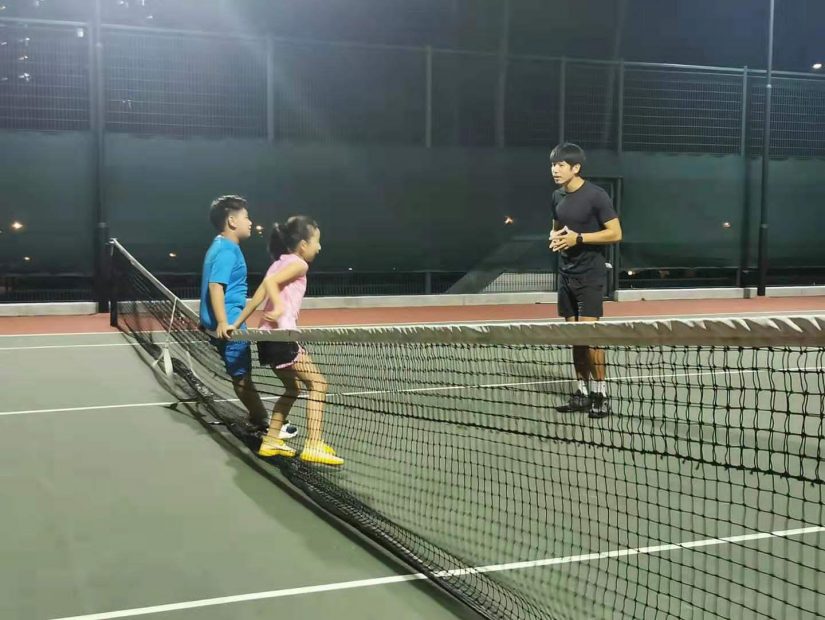For an intermediate player, the basic movements, techniques, and rules of the game will be familiar to you. You should be able to hold a rally with six players, serve, and then start a point. Perhaps you are still learning the game or maybe you haven’t played in a while so you are a little rusty. You’re likely to have had coaching in the past, whether it was individually or in a group. You must be eager to improve your skills and refresh your memory.
You will need to improve your technique to be a more confident player. You can start by improving your serve. This will allow you to hit the ball with more consistency and accuracy. While you may have been able to achieve topspin with a forehand, you will need to be able to do the same with a backhand. You’ll need to be more strategic and create match play strategies at this level. Here tennis lesson plans for intermediate players would work the best.
Blue group coaching sessions are great for intermediate players. Our coaches will help you improve your technique and become more tactical. Social tennis is a great way to meet new people and improve your technique. These will include the following drills and lessons.

Slicing
Slice or Backspin might be an important part of tennis lesson plans for intermediate players. It causes the tennis ball’s spin to return to the point of impact (you). Slice shots bounce low and force your opponent to stretch hard to reach the ball. Slicers are great for players who love to attack the net and volley. Slice is always a way to control. The forehand version of the slice is hit high to low, with the strings touching under the ball. Before you begin your forward swing, lift the racquet to shoulder height. Then, turn the face up so that the hitting surface faces upwards. Slice the ball by using a long, smooth stroke. Slice forehand is a simple technique that hackers often use.
GroundStokes: More power
Groundstrokes are usually used in baseline rallies. They can be used in any court. After the ball hits the ground, the tennis groundstrokes are shots that tennis players make. There are two types of strokes in tennis lesson plans for intermediate players: forehand groundstroke and backhand groundstroke.
To perform the forehand groundstroke, move the racket along your body and then point it in the direction you want to hit the ball. For right-handed players, the forehand groundstroke begins on your right side. The movement continues across your body until your racket faces come in contact with the ball. A full follow-through is required for the tennis forehand stroke.
The backhand groundstroke is where the player swings his racket in the direction he wants to land the ball. The backhand groundstroke can be used in baseline rallies, just like the forehand stroke. If the player wishes to perform an approach shot, however, the backhand stroke can be used. This tennis stroke is possible with two hands. It’s called the two-handed backhand. You can also do it with one hand, the one-handed backhand.
Take the ball up-and-coming
Focus and determination are key to winning the game of tennis. It is more difficult to move to the ball than wait for it. Many recreational players wait to get the ball because it is more convenient for their bodies and they do what feels right. If more people were to be aware of the many benefits of moving to the ball, and how they apply to other sports, then I’m sure that more players would consider buying in.
Dynamic drills
Dynamic drills are one of the most important in affordable tennis lessons Singapore plans for intermediate players. It definitely helps them attain good gestures and posture. A few of them are:
Get the ball deep
This drill helps to maintain a consistent shot length, serve well, and keep the player on his game. You can play this drill with your partner. The player should aim to hit the ball deep but not above the net.
Playing down the Alley or Pyramid
To improve their accuracy, players will use this drill to keep them aiming at specific areas on the court. Players can aim at small areas over the net from different court positions. They can also stand in different court positions. As the accuracy improves, these areas can be reduced and players can move around the court.
Serve Drills – Motion, Power, and Consistency
Another fundamental stroke in tennis is the serve. To improve your tennis serve, you can break it into three drills. This will increase power, motion, and consistency. Focus on the ball and use the correct muscles to serve it. This will improve your motion. To serve a stronger serve, your arms and legs must be fully utilized. Begin warming up by doing jumping squats on the cones or court lines. Next, focus on the muscles that are used when serving. Once the player is able to control both power and motion, they can concentrate on consistently serving. Serve ten to twenty balls, aiming at one box on the court or a smaller area marked with cones if you want to score the highest possible scores.
So these include some tennis lesson plans for intermediate players. There is still a long way to go, yet you would have learned a lot at this level. This would assist you in improving your game to a great extent.
